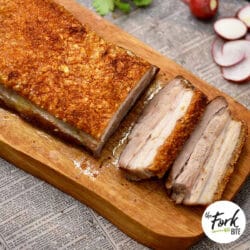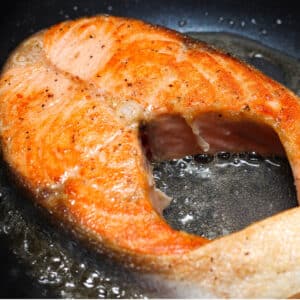How to reheat pork belly or lechon kawali can be tricky. Doing this incorrectly will not result in a good eating experience. It would be best if you had the lechon kawali crispy and tender like the first time you had it. The reheating method does not matter at all. Your goal will always be the same.
Preserving the texture in the crispy pork belly or lechon kawali upon reheating is crucial. It brings back the quality you wanted when you first ate it, fresh from the restaurant.
There are tricks on how to reheat pork belly. On its own, leftover lechon kawali can be boring. It can even be either tough or soggy. If you reheat it right, you can enjoy it again.
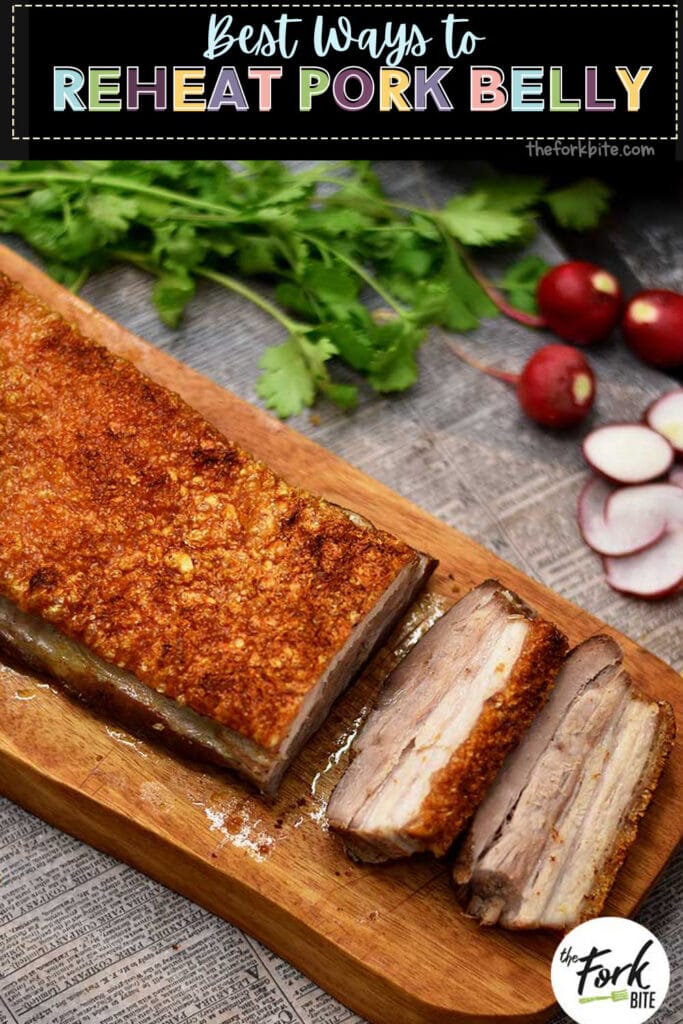
The technique of reheating leftovers has a science to it. The primary goal is to heat the food and keep its freshness, flavor, and texture.
There is always a basic rule to reheat, and that is to do it the way you cooked the food initially. This would result in nearly as good as when you prepared it the first time.
Busy people need help in reheating food that was cooked with much preparation. Most people did not have the time to fire up the grill to reheat the leftover sticks of barbecue last night. You would not use liters of cooking oil to reheat a chunk of pork belly or pork crackling.
What is pork crackling or lechon kawali?
Crispy pork belly or Lechon kawali, also known as "lechon de carajay" is a popular recipe. It is basically a slab of pork belly, deep-fried in a wok or deep pan. In the Philippines, it is often served with lechon sauce or a dipping sauce. It is made of "Toyo Mansi" or pork liver.
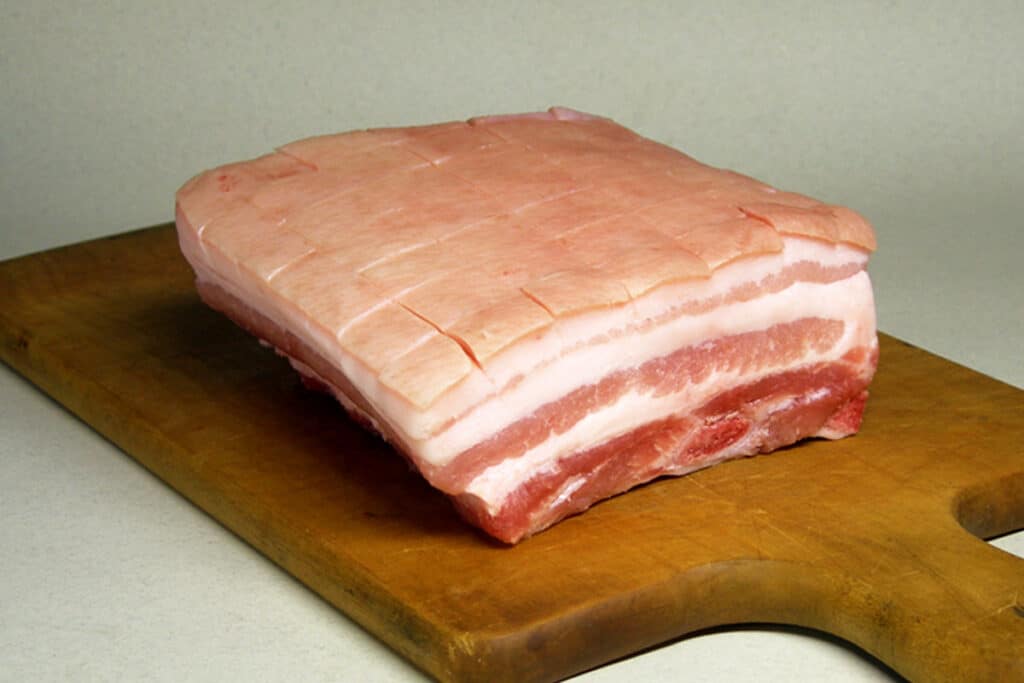
Credit: Rainer Zenz CC License
What is the best pork cut for lechon kawali?
- The pork belly or liempo is the traditional cut for lechon kawali; this part has interlacing layers of meat and fat. It is one of the most delicious pork portions.
- Make sure you choose a cut of pork belly that has equal parts of meat and fat.
- Too much lean meat will result in a hard, chewy, and dry texture. It is ideal not to pick the thickest slab you can find.
- A liempo slab not exceeding 1 ½ inches thick will be a good choice.
How to reheat pork belly or lechon kawali?
Pork crackling or pork belly can be both ultra-crispy and super tender. In reheating pork belly, you would want to preserve as many desirable features as possible.
The best reheating results come from using an oven or air fryer. You can also use your microwave but it won't yield crispy skin despite that, be cautious not to overdo it.
You can also use them to reheat other choice cuts of pork or pulled pork. Whatever equipment you choose, you can still get the optimal results you want.
Effective ways how to reheat pork crackling
These will help you avoid that frustrating, rubbery bite:
1 The Oven method
The dry heat inside an oven can prevent the pork crackling or lechon kawali from getting chewy. Place it in an oven at 350° F. Refrigeration often surrounds the pork belly with moisture; hence, this condensation should go away in the oven's dry heat.
Checking on it will ensure that it is warmed through enough. The oven technique is one of the most optimal ways to maintain the crispiness of the skin and the tenderness of the meat without making it rubbery or drying it out.

Step 1
- Remove the pork from the fridge and let it sit outside to reach room temperature for about 20 minutes more or less.
- Place the pork belly or lechon kawali skin side up in the center between two layers of aluminum foil.
Step 2
- *This is optional >> Pour in ¼ cup of apple juice (or wine, stock, or water around the side of pork belly EXCEPT for the skin before sealing the foil). {Or you can also lather or rub the pork meat (not the skin) with sauce before securing it with foil}.
- Dab skin with paper towels. Brush skin with vinegar (this helps conduct heat evenly). Trust me, dry skin = crisp crackling.
- Wrap the pork, careful not to puncture the foil.
Step 3
- Preheat oven to 350° Fahrenheit.
- Place the pork belly or lechon kawali foil package on a baking tray.
- Place the tray on the middle shelf of the oven.
- Heat this cut for about 7 to 10 minutes, depending on how big the leftover is.
- Pat the pork gently with a spoon or knife to test if the skin crackles. If you hear crackling, it is a success.
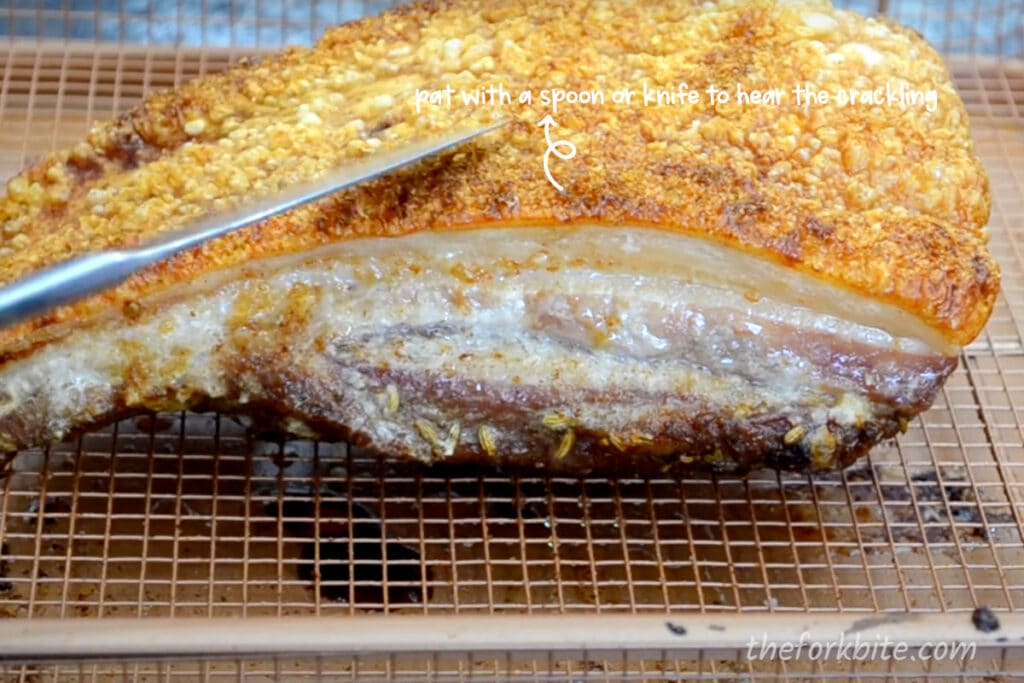
Step 4
The tender piece of meat from the oven already looks delicious. All that is left is to restore the crispiness of the skin. Caramelizing the edges is also a goal to keep in mind.
- Unwrap the lechon kawali and place it back on the baking tray skin side up. Be sure to keep an eye on it for about 5 minutes. Set the oven to broil or grill.
- The pork belly starts to caramelize, be crispy, and dehydrate during this time. If you cooked the lechon kawali in a slow cooker or sous vide, you would aim to keep the meat moist as well. Just let it broil for half the time.
2 Toaster oven method
Toasting bread is the primary use of this kitchen appliance. It is for reheating food that you cooked with dry heat. It is also a versatile tool for reheating many dishes.
A toaster overheats up right away. The result you get is always golden, hot, and crispy. The plus side of using this tool is that you can enjoy your pork belly or lechon kawali earlier than expected.
If you want to use your toaster oven, review the mentioned instructions for reheating pork belly or lechon kawali using the oven.
Pro-tip:
Knowing how to reheat pork belly with a toaster oven is easy. Choosing the right toaster oven is crucial if you want to use it for reheating dishes like lechon kawali.
- A toaster oven with different temperature options is an optimal piece of appliance.
- Low and low reheating is the best way to keep the meat from drying out right away.
- Spreading your food in an even layer is necessary to achieve the best results.
- Covering the food with aluminum foil will protect the lechon kawali from having burnt spots. This will also provide good insulation.
A toaster oven is best for reheating the following:
- Baked goods· Fried food (without breading)·
- Waffles and pancakes
- Roasted meat
- Sandwiches and burgers
- Grilled meat
- Burritos and quesadillas
- Baked pasta dishes
3 Air fryer method
Using an air fryer is the quickest and easiest way to satisfy your cravings for pork belly. Using this kitchen appliance correctly will give you crispy skin and moist pork, better than the first time you had it.
Note:
Be mindful of using an air fryer; this can dry up the pork belly right away because of its superheated dry air.
A super easy trick to bring back life to your refrigerated pork belly or lechon kawali
To correct the soggy pork skin, you just need to use an oven, air fryer, turbo broiler, or toaster oven. The microwave will not give you crispy skin. After reheating, you will get a fresh piece of pork belly or lechon kawali.
Step 1
Preheat the air fryer to 375° Fahrenheit.
Step 2
Position the pork belly skin side up. If it cannot stand straight, lean it to one side. That way, the skin will still be facing more heat.
Step 3
Check the pork belly after 5 to 6 minutes; this will help you see how things are progressing. If the leftover slab is much bigger or thicker, it can take at least 8 to 10 minutes.
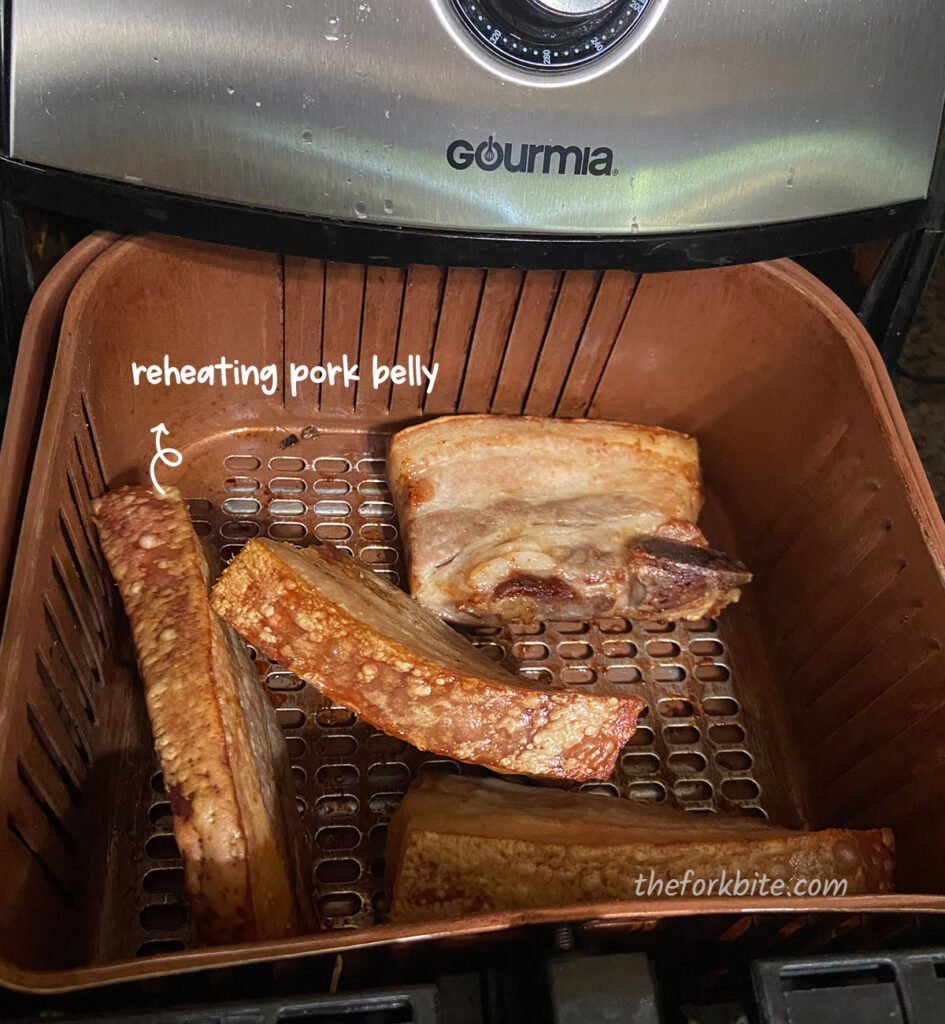
4 Microwave method
This method is for those who are in a pinch. It is easier to overdo the reheating using the microwave. Doing it in short bursts will give you great results. Even so, it is convenient and easy.
The microwave is your best friend in quick pork belly reheating. But the downside is that pork belly meat might become rubbery and chewy with this technique. You can do a few tricks to make the results better.
Microwaves function by heating the water molecules in the food. It makes the molecules vibrate. Foods that contain more moisture heat up more quickly. This is because of the large number of water molecules.
Most meats tend to heat up right away in the microwave. As these water molecules vibrate and heat up, part of them become steam. If you overdo it, you can end up with a rubbery pork belly.
Instead of turning the food crispy, the food becomes chewy. But if you do not have access to an oven, using a microwave will do.
Here is how to reheat pork belly using a microwave:
Step 1
Place the pork belly or lechon kawali in a microwave-safe dish and sprinkle three tablespoons of water or juice/broth to handle the moisture.
Step 2
Heat the pork belly in 30-second bursts using medium heat or until you reach your desired temperature.

How many times can you reheat pork belly?
You can reheat pork belly from the fridge or freezer. Experts recommend reheating pork belly only one time to ensure optimal results.
It is safe to reheat meat many times as long as the meat stays out of the danger zone temperature of 40° Fahrenheit to 140° Fahrenheit.
Even so, you will continue to lose moisture, flavor, and texture in your meat each time this happens. Also, make sure the internal temperature of the meat you reheat is 165 degrees Fahrenheit before eating them.
How long does pork belly last in the fridge?
Refrigerating the leftover pork belly in heavy-duty plastic wrap or aluminum foil or shallow and airtight food containers can help you maximize the shelf life of your pork belly.
This also helps ensure the quality and safety of the meat. Your leftover lechon kawali can last for 3 to 4 days in the fridge.
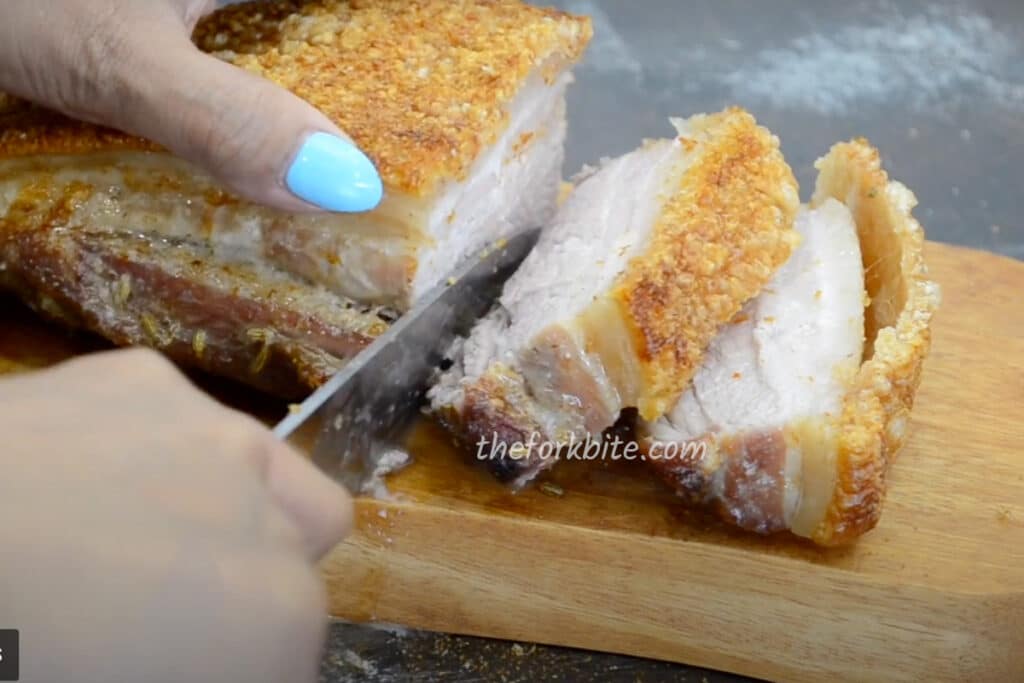
Best tips for cooking pork belly or lechon kawali
Tip 1 Boil the pork
Boiling the pork belly will help render out some of the fat. This will help add more crispiness during frying. I have read other recipes on how to reheat pork belly.
Some recommend boiling in seasoned water containing peppercorns, soy sauce, garlic, and bay leaves. Others recommend boiling the pork slab in saltwater.
Pork that simmered with more seasonings has a light-brown appearance. After frying, it gave superb flavor as well.
Simmering involves covering the pot and then lowering the heat to a medium-low. Do this until the slab of pork belly is tender but not to the point of falling apart. It may take 45 minutes or so, depending on the size of the pork belly.
You do not need to cook the slab through yet. The pork skin must be softer but not falling apart. This is vital for the next part of the process.

Tip 2 Puncture holes in the skin.
The crispy bubbles on the pork are from the holes on the skin. You will need a fork, meat tenderizer, tip of the knife, or barbecue sticks to puncture the skin.
Make sure not to puncture the meat. The oil will seep into the meat and harden it if this happens.
More holes in the slab's skin will make it crispier. This will allow the skin to have openings for moisture to come out of. This will dry out the skin. It will then crisp up in the hot oil later.
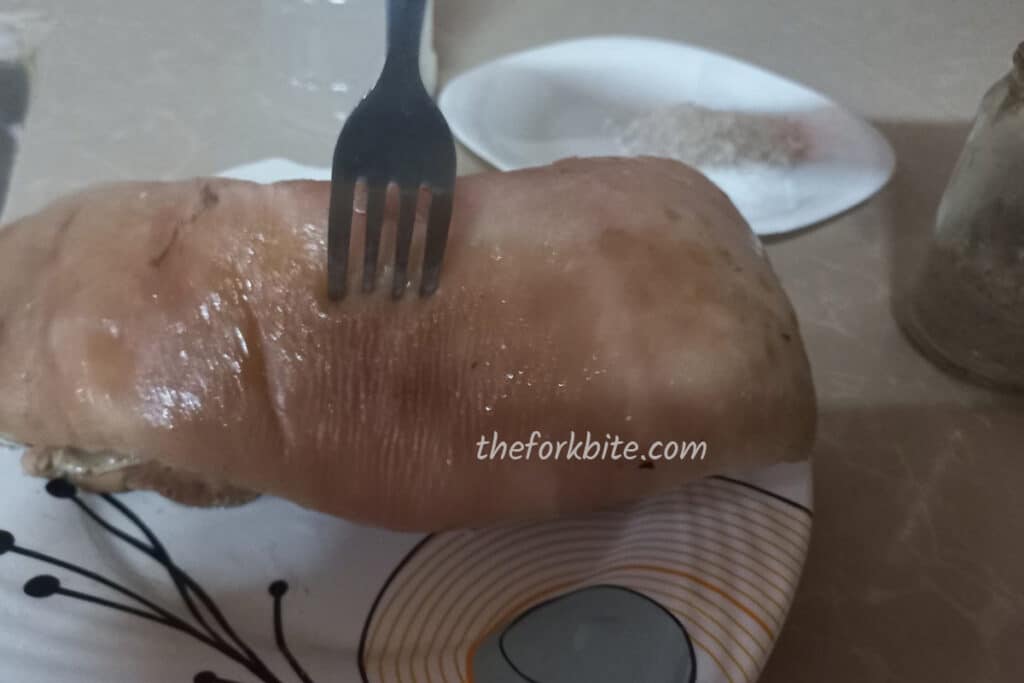
Tip 3 Sprinkle salt and store in the fridge
Make sure to get a good handful of high-quality salt and massage it into the pork skin. Leave the pork in the fridge uncovered overnight.
You can also use your favorite dry rub spice mix on the meat alone. This will pull the moisture out of the slab's skin. If there is less moisture, the skin will be crispier.
You can choose to hang pork belly strips in front of a fan overnight, uncovered. This will dry out the pork more.
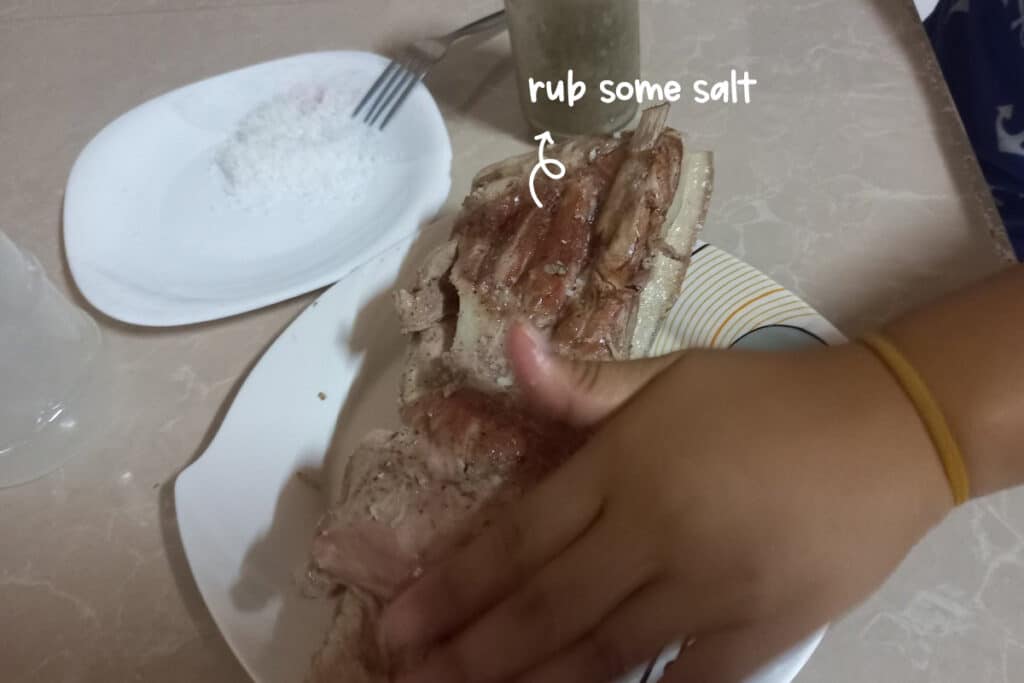
Tip 4 Prepare for frying.
A clean kitchen towel or disposable paper towels can do the job. You can rub down the pork after drying it overnight. This will remove the excess salt and moisture, ensuring the complete dryness of the pork slab.
The pork will have a funky smell. If you want to remove this, just brush the top skin with vinegar before frying it.
White vinegar may remove the odor, but it can also help dry out the skin since it is acid. You will need just a light coating of white vinegar.
At this stage, you can go ahead and slice your pork slabs into cubes if you prefer. This will result in faster frying. The same happens if you slice the pork slab into long strips. You can just fry the entire slab and just slice it after.
2 Ways of cooking pork belly
1 Deep frying
For this technique, you should heat the oil to the right temperature. Using a deep-fry thermometer will make this easier.
You can also use the following methods:
1 Chopstick method
Get a barbecue stick, a wooden spoon, or a chopstick and dip it into the heating oil. The oil is ready if the oil bubbles around the stick. The forming of a few bubbles means the oil is not hot enough. Vigorous bubbling implies the oil is too hot.
2 Bread method
You can also drop a piece of bread into the oil. This will tell you how hot or cold the oil is. Watch how fast it browns.
3 Hand method
You can also place your hand over the hot oil. Once you cannot take the heat for five seconds, the oil is ready. Longer than five seconds means the oil is not ready yet. A shorter time means the oil is too hot.
Cook the pork until it is crispy enough.
Slowly slide the pieces of pork into the hot oil. Do not disturb it. Remove the pork slices when the skin is crispy and crackly.
Tongs will help you get a good grip of the lechon kawali. Place it on a wire rack. Do not place it on paper towels. The wire rack will help isolate the moisture and oil from the pork belly. It will prevent the lechon kawali from being soggy.
2 Baking in the oven
Prepare the pork:
- Get a sharp knife or any sharp or pointed tool. Put holes into the pork slab's skin. Make sure not to reach the fat or meat.
- Invert the pork belly. Rub the meat part with Chinese cooking wine.
- Rub fennel seeds, five-spice powder, and cumin all over the meat part. Do not include the skin.
- Turn the pork belly skin side up again and place it in a food container. Pat dry the skin with paper towels. Refrigerate it overnight or for 12 hours uncovered.
Bake the pork:
- Preheat your oven to 350° Fahrenheit.
- Get the pork from the fridge. Place it in a large sheet of aluminum foil.
- Fold up the sides of the foil around the pork to cover it well.
- Transfer the pork to a baking tray. Pat the skin with paper towels. Then, brush the skin with white vinegar to dry it more. Vinegar also helps disperse heat evenly.
- Rub rock salt on the skin. Then, bake the pork slab for 60 minutes (more or less depending on the size of the pork). Reduce the baking time if you boil the pork first before placing it in the fridge.
- Once done, remove the pork from the oven and place it on a work surface.
- Turn the mode to medium-high broil or grill. Make sure it is about 12 inches from the heat source.
- Fold the foil down and scrape the salt off the sides or the top of the pork slab. Remove the foil and place the pork slab again on the baking tray.
- Place the pork slab under the broiler or grill for about 20 to 25 minutes. You should rotate the tray until the skin is puffed, golden, and crispy.
How to reheat Pork Belly or Pork Crackling
Pin RecipeEquipments:
- Oven
- Air Fryer
- Microwave
- Toaster oven
Ingredients:
- leftover pork belly
Instructions:
Using Oven Method:
Step 1:
- Remove the pork from the fridge and let it sit outside to reach room temperature for about 20 minutes more or less.
- Place the pork belly or lechon kawali skin side up in the center between two layers of aluminum foil.
Step 2:
- *This is optional >> Pour in ¼ cup of apple juice (or wine, stock, or water around the side of pork belly EXCEPT the skin before sealing the foil). {Or you can also lather or rub the pork meat (not the skin) with sauce before securing it with foil}.
- Dab skin with paper towels. Brush skin with vinegar (this helps conduct heat evenly). Trust me, dry skin = crisp crackling.
- Wrap the pork, careful not to puncture the foil.
Step 3:
- Preheat oven to 350° Fahrenheit.
- Place the pork belly or lechon kawali foil package on a baking tray.
- Place the tray on the middle shelf of the oven.
- Heat the pork for about 7 to 10 minutes, depending on how big the leftover is.
- Tap the pork gently with a spoon or knife to test if the skin crackles. If you hear crackling, it is a success.
Step 4:
- Unwrap the lechon kawali and place it back on the baking tray skin side up. Be sure to keep an eye on it for about 5 minutes. Set the oven to broil or grill.
- The pork belly starts to caramelize, be crispy, and dehydrate during this time. If you cooked the lechon kawali in a slow cooker or sous vide, you would aim to keep the meat moist as well. Just let it broil for half the time.
Notes:
Best tips for cooking pork belly or lechon kawali
tip 1 boil the pork
Boiling the pork belly will help render out some of the fat. This will help add more crispiness during frying. Some recommend boiling in seasoned water containing peppercorns, soy sauce, garlic, and bay leaves.tip 2 puncture holes in the skin.
The crispy bubbles on the pork are from the holes on the skin. You will need a fork, meat tenderizer, tip of the knife, or barbecue sticks to puncture the skin. Make sure not to puncture the meat. The oil will seep into the meat and harden it if this happens.tip 3 sprinkle salt and store in the fridge
Make sure to get a good handful of high-quality salt and massage it into the pork skin. Leave the pork in the fridge uncovered overnight. You can choose to hang pork belly strips in front of a fan overnight, uncovered. This will dry out the pork more.tip 4 prepare for frying.
A clean kitchen towel or disposable paper towels can do the job. You can rub down the pork after drying it overnight. This will remove the excess salt and moisture, ensuring the complete dryness of the pork slab.Please note that all nutrition information are just estimates. Values will vary among brands, so we encourage you to calculate these on your own for most accurate results.

